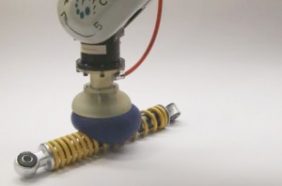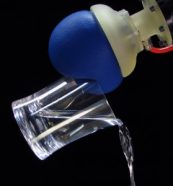Coffee gives robots a grip
Ground coffee, balloon and vacuum create robotic 'hand'
Sometimes, scientists use coffee to come up with new ideas — though not necessarily by drinking the caffeinated beverage. In the case of one new invention, scientists used coffee grounds to build a new tool that can help robots lift, hold and move objects.

But the new tool, called the “universal gripper,” suggests robots don’t need fingers to move things around. It’s a simple device made of a small balloon filled with coffee grounds and attached to a vacuum. This strange but smart design means the robot gripper can pick up all kinds of objects, including fragile things.
QUICKER PICKER UPPER from Science News on Vimeo. A robotic gripper made with coffee grounds shows off its versatility. (Don’t miss the egg.)
Credit: John Amend
“One of the tricky things about picking up delicate objects is that you have to know how much pressure to apply: too little and you drop the object; too much and you break it,” Peko Hosoi told Science News. “This new gripper works by exactly conforming to the shape of the object.”
Hosoi is a mechanical engineer at the Massachusetts Institute of Technology, or MIT. She did not work on the new gripper, but she says it’s a good idea.
Coffee grounds, like grains of sand, are very small. When they’re all together in a container, they sit very close together. When you dump ground coffee, or pour sand, you probably notice that these materials flow like a liquid. That’s because in a liquid, the molecules are free to move past each other — just as the grounds or grains can.

When the balloon bag sits on top of an object, such as a marker, it changes shape and fits around the object. Then the vacuum starts and sucks the air out of the coffee-filled balloon. With the air gone, the grounds move closer together and can no longer flow freely. They act more like a single solid object, and stiffen around the object. And because they had at first acted like a liquid, now that they’re acting like a solid, the grounds are stuck together in the shape of the marker. At this point, the robotic tool has a strong grip on the object and can lift and hold it.
In a video produced by the scientists, the robotic tool is shown lifting all kinds of objects, including a jack, an egg and a shock absorber. The video also shows that the tool allows a robot to write with a pen or pour water from one glass into another.
“Our goal was to pick up objects where you don’t know what you’re dealing with ahead of time,” Eric Brown told Science News. Brown is a scientist at the University of Chicago who worked on the new tool.
The new tool is small, but the scientists are thinking big. They say that a giant gripper three feet across would be strong enough to lift and move something weighing 2,000 pounds — like a small car.
Of course, to get enough grounds to fill such a big balloon, the scientists would need a lot of coffee.







